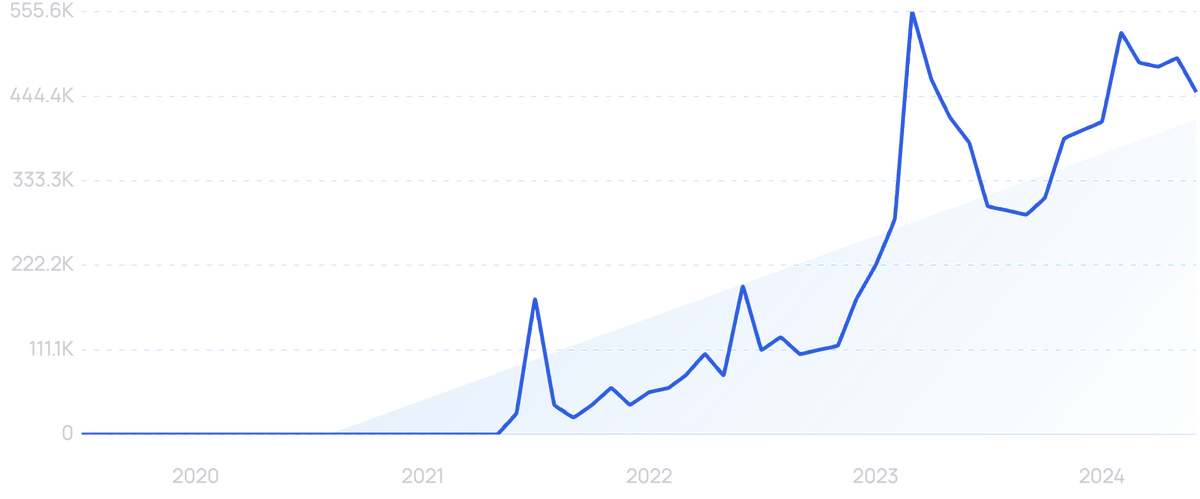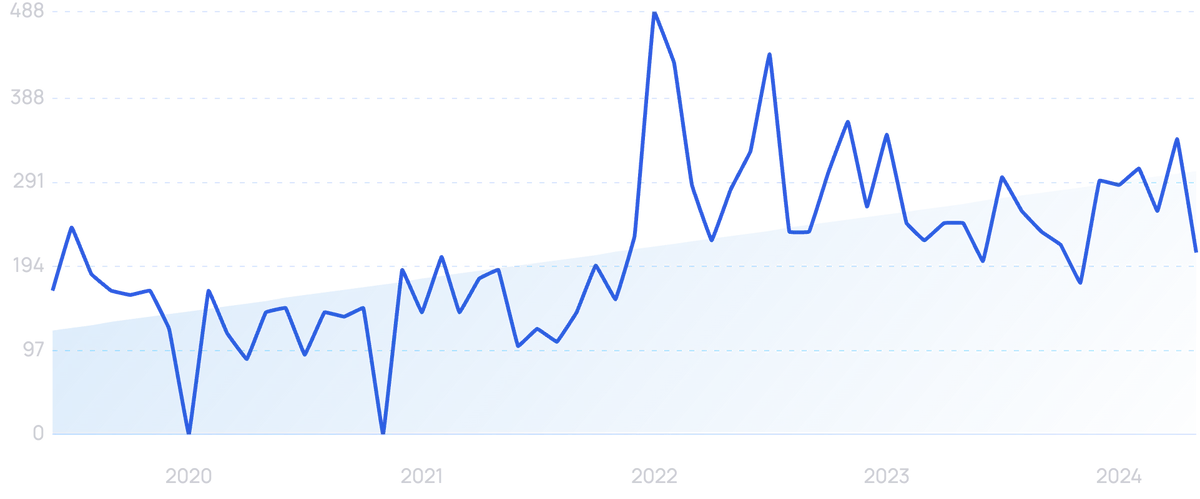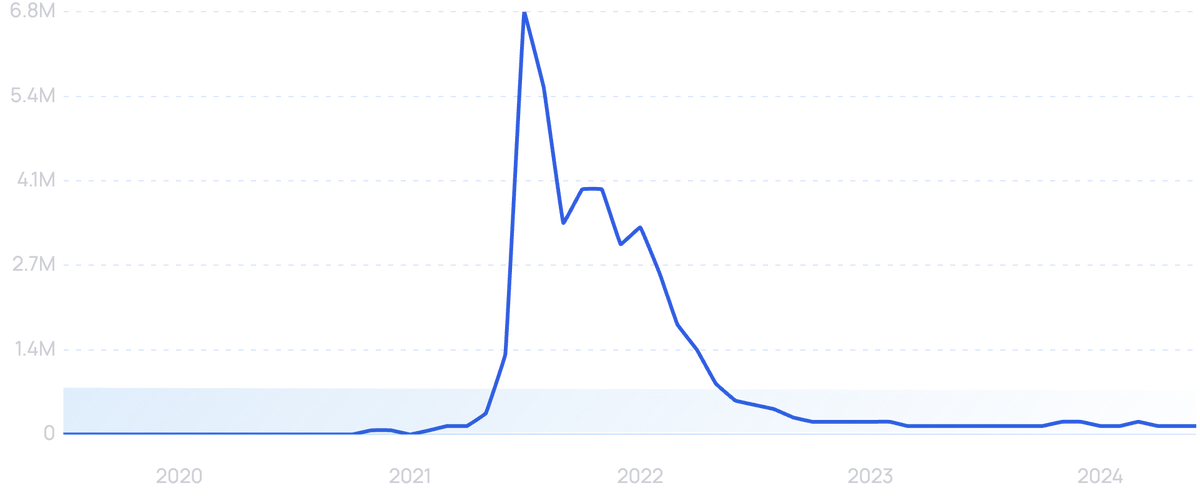
Top 11 Software Development Trends (2025 & 2026)
You may also like:
The software industry is currently in flux.
From no-code apps to generative AI, the way software is conceptualized, developed, and maintained is rapidly changing.
Where will software and tech take us in the near future? Let’s dive right in.
Here are the top 11 software development trends happening right now:
Build a winning strategy
Get a complete view of your competitors to anticipate trends and lead your market
1. AI adoption accelerates
AI is increasingly impacting nearly every industry.
And software development is no exception.
AI tools like GitHub Copilot have the potential to turn any developer into a 10x developer.
Searches for Github Copilot are up 8,000% over the last 5 years.
In the future, AI may be used to automatically debug code before it ships.
Besides aiding in software development, AI tools are also being implemented to help improve processes in a number of different industries.
One of the other industries in which AI software is poised to make the biggest impact in the coming years is healthcare.
A Deloitte study revealed that the top three goals of AI in healthcare are to lower costs, improve efficiency, and enhance existing products and services.
For example, AI software can improve symptom analysis in patients, detect medication errors, and automate administrative tasks.
Another sign that healthcare AI is an important trend: venture capitalists have invested more than $8.5 billion in the top 50 healthcare AI firms.
In the business world, AI software is making an impact through Robotic Process Automation (RPA).
This type of technology automates mundane tasks so that skilled workers can focus on projects with higher potential value.
One survey showed more than 50% of businesses are using RPA and nearly 20% who aren’t using it now expect to start in the next two years.
Here are just a few examples of what businesses are using RPA for in 2025: data entry, mass emails, lead nurturing, financial planning, payroll, and compliance.
Searches for “AI software” are up 929% over the last 5 years.
Additionally, AI code editors and assistants are making it easier than every for people to build applications.
Popular tools like Claude Code, Cursor, Lovable, and Windsurf are all growing quickly.
In fact, Cursor just surpassed $500 million in ARR and supports more than one million total users.
Searches for “Cursor AI” are up 9,100% over the last 2 years.
According to Semrush, Cursor gets 14.2 million monthly website visits from 6.2 million unique visitors.
2. Businesses adopt low-code and no-code development
Despite the rise of AI copilots to help code, development is often riddled with problems and setbacks.
One survey found that 20% of all software projects fail and another 52% are “challenged”.
Of course, creating software can be incredibly expensive, too.
These factors have led some in the software development industry to start encouraging a simplified way of creating software: low-code/no-code development.
The popularity of “low-code” has exploded and searches are up 286% over the last 5 years.
As its name implies, developing software in this way does not utilize advanced IT knowledge or coding skills.
Low-code and no-code development can translate into easier, faster development.
No-code platforms allow users to drag and drop blocks of pre-made code in a visual interface.
Search growth for "no-code" is up 950% in 5 years.
Low-code platforms are a bit more technically involved, but provide shortcuts that help developers work quicker.
KPMG reports that 100% of enterprises that have put a low-code platform into place have reported a positive ROI.
They also say that the number of business executives who list this type of development as their most important automation investment has nearly tripled since the pandemic began.
According to Gartner, as of 2023, more than half of all medium to large enterprises are likely to have adopted a low-code application platform.
Bubble is one example of a visual development tool that’s been used to build everything from budgeting programs to project management tools to virtual learning apps
Bubble is a growing no-code tool for creating web apps.
The company has raised $106M in VC funding to date.
Adalo is another popular no-code platform. The startup announced an $8 million series A round.
3. Remote work drives an increase in cloud computing
As much as COVID-19 was the downfall for many industries, it prompted the rapid acceleration of cloud computing.
During the pandemic, most businesses expanded remote work capabilities and experienced a huge shift in IT needs.
The cloud was the perfect tool to help companies that needed to shift and adjust to the increased demand of this "new normal".
More than 90% of respondents in one survey said that cloud usage grew due to the pandemic.
In many businesses, cloud usage is expected to increase significantly this year.
But the pandemic also showed how useful the cloud can be to businesses who need to down-scale.
For example, the bottom fell out of the tourism industry and those using cloud services don't need to maintain expensive data centers when they didn’t need them.
Even though global IT spending decreased in 2020, cloud spending grew by more than 6% to a total revenue of $258 billion.
Experts say the market will double over the next few years.
Cloud spending was up in 2020, and experts expect this spending increase to continue in 2021.
Global tech consulting firm Accenture launched “Cloud First” with a $3 billion investment in September 2020.
The move created a group of 70k cloud professionals working to get Accenture’s clients moved to the cloud quicker and more efficiently.
Due to the massive growth in this industry, demand for cloud-native software engineers has never been higher.
This is especially true for individuals with experience in Software as a Service (SaaS), Infrastructure as a Service (IaaS), and Platform as a Service (PaaS).
Searches for “cloud engineering” are exploding with a 178% increase in the past 5 years.
Amazon, which holds a 31% market share in cloud infrastructure services as of Q1 2025, is working proactively to train more people on cloud computing.
The company offers an array of training and courses in the IT world, with a focus on AWS.
4. Malicious software development ramps up
Cybersecurity will likely remain a major concern in the next few years.
Ransomware, in particular, is a threat that’s expected to increase.
That means businesses will be looking for the right tools to keep their assets protected.
Searches for “cybersecurity” continue to rise. The topic has grown 233% in 5 years.
Ransomware attacks increased from 183.6 million in 2017 to 623.25 million in 2021. However, these figures have dipped since, falling to 317.59 million in 2023.
Attacks in recent years have been devastating.
Hackers have targeted United States government agencies, hospitals, and major energy companies.
One of the latest trends in ransomware is double extortion.
In this malicious tactic, attackers first hold the company’s data for ransom. Later, they threatened to release that data if another ransom wasn’t paid.
In one report, IBM said double extortion attacks accounted for 59% of the ransomware attacks that IBM Security X-Force handled last year.
How businesses are protecting themselves against ransomware is evolving in 2025.
IBM Security reports that organizations with fully deployed security automation potentially save themselves $3.58 million in the event of a data breach than those who don’t have automation deployed.
Many organizations are going so far as to invest in cyber insurance.
Google search engine demand for "cyber insurance" is up 475% over 10 years.
In fact, Colonial Pipeline, the owner of the nation's largest fuel pipeline network that fell victim to a ransomware attack in May 2020, reportedly had a $15-million policy.
The number of cyber policies increased by 60% between 2016 and 2019.
However, ransoms and the losses associated with the attacks are so expensive that insurers may no longer offer coverage for these events in the coming years.
5. Rust gains momentum
Rust is the programming language having a breakout few months.
It’s been voted the “most beloved language” in StackOverflow surveys.
Rust is by far the most-loved coding language according to Stack Overflow.
Searches for “Rust” have increased 48% in the past 5 years.
Rust was released in 2010 by Mozilla Research.
However, in early 2021, the formation of the Rust Foundation was announced.
The Foundation now owns all trademark and infrastructure assets.
Part of the appeal of Rust is that it’s a “memory safe” language, which means that it eliminates the risk of memory-related bugs in the software.
It’s also praised for its speed, security, and performance.
In a recent survey of .NET developers, Rust was the second choice when users were asked what language they were interested in learning.
In the past year, the language also moved up 18 spots on the Tiobe popularity index.
Some big-name companies, like Facebook, Dropbox, and Amazon, use Rust in production.
And, several large corporations are investing in the language, too.
This programming language has even been used by hackers in writing malware.
It’s nicknamed RustyBuer.
6. Continued expansion of the IoT
The Internet of Things (IoT) is set to continue expanding in 2025 and beyond.
Stats show that there will be 65 billion IoT devices in 2025. That’s 6x more than in 2018.
In late 2020, the number of IoT connections surpassed the number of non-IoT connections.
In particular, smart speakers are expected to continue in an upward trend. Data shows the market could be worth $35.5 billion in 2025.
Forrester predicts that wearables and sensors aimed at allowing patients to monitor their own health at home will surge in 2021 and beyond.
The data that’s collected from the patients can enable doctors to be proactive in medical treatments and improve care.
Searches for “remote healthcare” have increased by 475% over the past 5 years and have remained high since the pandemic.
The IoT goes way beyond use in homes.
Bayer recently developed an inexpensive IoT chip that’s similar to a mailing label.
It can be attached to anything from chemical compounds to seed packs to track items after leaving the warehouse and throughout distribution.
There are also wide-ranging capabilities of the IoT making an impact in the workplace.
Most notably in 2020, companies considered using RFID tags to monitor employees’ hand washing and social distancing.
7. Progressive Web Apps (PWAs) Aim to Provide a Better User Experience
Smartphone users want their app experience to be fast and reliable, but oftentimes, they don’t want to download apps because they take up too much space.
In fact, Google found that half of smartphone users are likely to use a brand’s mobile site because they don’t want to download an app.
Many companies are turning to progressive web apps (PWAs) to find a solution.
These offer the ideal combination of standard website technology and the convenience of an app.
Developers tout PWAs as the best of both worlds.
Compare the native app to the PWA from Twitter, for example. The brand’s PWA takes up only 3% of the storage of the Android app.
PWAs run on HTML, CSS, and JavaScript like websites do, but they take away the browser interface and borders.
Unlike native apps, users do not need to download PWAs. They simply save them to their home screens.
Users visit the PWA URL once and then they’re able to add the icon to their home screen.
PWAs load quickly and send push notifications just like a native app. And, because they cache data, they’re even available offline.
One attribute that makes PWAs increasingly popular with developers is that they’re platform agnostic — developers don’t have to build a separate app for mobile, tablet, and desktop.
Ease of development is just one-way PWAs save brands money. These apps are also quicker to design and cost less to maintain.
One estimate says PWAs can cost up to 15 times less than a normal mobile app.
Starbucks is one company that’s already taking full advantage of the benefits of a PWA.
To start, it’s 99.84% smaller than the brand’s iOS mobile app.
Starbucks’ PWA is especially convenient for customers who don’t have a reliable network connection throughout the day.
The brand’s PWA allows customers to browse the menu and even customize their orders without being connected to the internet. Once they are connected, they can see specific pricing for the nearest location and place their order.
Since implementing the PWA, Starbucks has doubled the number of web users who place orders each day.
8. Microservices Architecture Simplifies Deployment and Scaling
Technavio reports that the growth of the cloud microservices market is accelerating. They predict the CAGR will surpass 25% through 2026, adding $1.59 billion in market value.
Search volume for “microservices” is up 2,400% in the past 10 years.
Microservices architecture represents a new approach to software development.
The old approach, monolithic architecture, involves all the application processes being coupled together and run as a single service.
Because all of the code is grouped together, changing one process means changing the entire application. This approach is neither agile nor scalable.
With a monolith approach, all code is grouped together making updating a very time-consuming endeavor.
On the other hand, microservices architecture features modules built as independent services. Each of these modules supports a specific task or goal and uses an API to communicate with other sets of services.
The modules can be built, managed, and changed without altering other modules.
This new structure means microservices require less development time and can be scaled easily. They can also be reused in other projects.
IT teams also save time and money when a problem occurs.
If something goes wrong in a monolithic architecture, teams have to troubleshoot, test, and update the entire software. With microservices, the fault is isolated, remediated, and redeployed within a single service.
In a 2021 IBM survey, 88% of current microservices users said they agree or agree completely that microservices architecture offers many benefits to their development teams and 87% agree or completely agree that the effort and expense of adopting this approach will be worth it.
One of the most popular tools to use within microservices architecture is Docker.
Docker provides containers that encapsulate each service. Each container has the source code and operating system libraries required to run that service in any environment.
This becomes incredibly useful in automating the deployment of applications.
Docker has developed container technology that’s portable, flexible, and easy to deploy.
9. Use of Blockchain in Software Development Expands
The majority of the buzz surrounding blockchain technology has been focused on cryptocurrency.
However, the technology has implications for the software development industry as well.
Search volume for “blockchain software development” is up 26% in the past 5 years.
Overall, the blockchain market is expected to grow to $291 billion by 2030.
Businesses across the globe are implementing blockchain in their organizations.
In fact, a survey by Deloitte found that 73% of executives feel that blockchain can give them a competitive advantage.
Deloitte’s survey shows growing interest and investment in blockchain technologies.
There’s a good reason for this.
Blockchain-oriented software (BOS) systems are robust and incredibly secure.
The data in the systems is replicated and decentralized, ensuring data security.
There’s also transaction recording and public-key cryptography, which add another layer of safety to the data.
There’s little risk of hacking or theft because users can view and record the software but they cannot modify or delete any data.
One area in which the security of blockchain technology is particularly appealing is software development for the healthcare industry.
For example, blockchain-based systems can bring together pharmaceutical companies, hospitals, insurers, medical device OEMs, and others. They can log contract details, track transactions, and provide payment details.
They can also automate the terms of their contracts using a technology called smart contracts.
Blockchain systems have the potential to track patients, avoid duplicate processes, and speed up the exchange of data.
Another instance of blockchain-based software is a specific type of app called a decentralized application (dApp).
As its name implies, there’s no centralized place where the code is stored and it’s not owned by any specific company.
In practical terms, this means that the “middle man” is unnecessary. For example, users don’t need a company like Airbnb or Uber. Instead, they can directly access the platform and its services.
One of the most popular dApps is a gaming app called Axie Infinity.
Search volume for “Axie Infinity” has increased 100% in the past 5 years.
In it, users can raise, trade, and battle digital creatures called Axies, which are NFTs.
The game boasted 8.3 million players and one million active daily users as of the end of 2021.
However, in mid-2022, the Axie network lost $620 million in a hack and lost half of its players, according to some sources.
Other blockchain games stand a good chance of luring those users to their platforms.
For example, Game of Silks, a horse racing game with NFTs, raised $2 million in funding in mid-2022.
10. Companies Turn to Outsourcing in the Face of IT Skills Shortage
Executives are eager to implement emerging technologies, but they’re having to do so with fewer staff members than ever before.
According to a 2021 Gartner report, 64% of executives say the talent shortage is the most significant adoption barrier for their business. That’s compared to just 4% in 2020.
A 2022 survey showed that 73% of technology leaders say it’s either very or somewhat challenging to recruit tech workers and fill their open positions.
In the coming years, industry experts say the talent shortage is only going to get worse.
By 2030, there could potentially be 85 million jobs that are unfilled, costing the global economy $8.5 trillion.
Breaking those numbers down, we see the potential for $162 billion in revenue losses in the tech sector if the US can’t fill high-tech positions.
To make matters worse, a survey from September 2021 showed that 72% of IT employees were considering quitting their jobs in the next 12 months.
Three-quarters of those surveyed said that their company focuses more time on attracting new hires than investing in their existing employees.
Survey results showed the pandemic and a lack of learning and training opportunities led many employees to consider quitting.
To combat the shortage, many companies are turning to non-traditional hiring methods.
In the past, software developers were expected to have an academic background and training. But, in today’s hiring climate, nearly 80% of HR professionals are open to hiring individuals who have been self-taught or trained in a bootcamp-style course.
IBM is one company that’s taking concrete steps to train the workforce it so desperately needs.
The company announced an ambitious goal in October 2021: to train 30 million people by 2030.
IBM CEO Arvind Krishna said, “We must take big and bold steps to expand access to digital skills and employment opportunities so that more people–regardless of their background–can take advantage of the digital economy”.
IBM will launch 170 new partnerships with academic and industry leaders. That’s in addition to their earn-and-learn apprenticeship program for those without a bachelor’s degree.
Outsourcing is another way IT departments are looking to scale and stay agile while avoiding the headache of recruiting and the pinch of attracting new employees with high salaries.
The IT outsourcing market reached $522 billion in 2021 and is expected to swell to $689 billion by 2027.
In one example, CSX transitioned 137 in-house IT jobs to Mumbai-based TCS (Tata Consultancy Services) in July 2022.
In a similar move, OhioHealth eliminated 567 IT jobs, citing plans to outsource the positions to Accenture, a professional services company.
A representative from OhioHealth said, “We’ve realized the best way to deliver in IT is to leverage the tools, technology, and global talent pool external partners can provide. These are areas that continuously have rapid growth. By leveraging the deep expertise of our partners, we will keep pace with these rapid changes in a better way than we could on our own.”
11. DevSecOps Approach Integrates Security into the Development Process
The combination of development, security, and operations (DevSecOps) represents a new software development approach that integrates security throughout the entire IT lifecycle.
Search volume shows growing interest (200% in 5 years) in “DecSecOps”.
In the traditional development approach, there was plenty of time for the code to go through testing and security processes because new software was released every few months or even years.
Today, new features and code are being pushed out very quickly, so quickly that security testing cannot keep up.
The DevSecOps integration is crucial when it comes to implementing security without slowing down development or delaying releases.
Instead of security being a concern at the tail end of the development process, developers can fix security issues in the code in real time.
The result is software that’s deployed as quickly as possible while being as secure as possible.
Fixing security issues earlier is much quicker and more cost-effective than fixing issues in the production stage.
Many teams are adopting this approach. In a 2021 GitLab survey, 70% of security professionals said their teams had moved security earlier in the development process. That was compared to 65% in 2020.
GitLab reports that respondents are becoming more confident in their security posture.
However, there’s still internal debate regarding the DevSecOps strategy.
The GitLab survey reported that 45% of security team members say that developers catch less than one-quarter of bugs in the code.
However, the ROI of utilizing the DevSecOps strategy is solid.
Those organizations that use the strategy deploy code 46x more frequently than low-performing teams.
These organizations also reduce costs 56% more effectively and are 144% more likely to resolve security flaws quickly.
Conclusion
That wraps up the 11 emerging trends in software development happening right now.
Interconnectivity, automation, and cloud computing are likely to continue on the path of rapid adoption. However, these developments do come with challenges.
Are we, as a society, ready to integrate this much technology into our everyday lives? Hackers are betting on it and are ready to pounce on any vulnerabilities.
Stop Guessing, Start Growing 🚀
Use real-time topic data to create content that resonates and brings results.
Exploding Topics is owned by Semrush. Our mission is to provide accurate data and expert insights on emerging trends. Unless otherwise noted, this page’s content was written by either an employee or a paid contractor of Semrush Inc.
Share
Newsletter Signup
By clicking “Subscribe” you agree to Semrush Privacy Policy and consent to Semrush using your contact data for newsletter purposes
Written By


Josh is the Co-Founder and CTO of Exploding Topics. Josh has led Exploding Topics product development from the first line of co... Read more





























